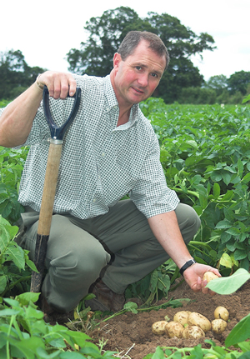
Picture: Andrew Farley(Agrownomics)
Late potato planting in the spring and a slow start to the season means potato growers will be tackling big crop haulms that are still vigorously growing come desiccation day, warns Devon-based potato specialist, Andrew Farley. This season, the Agrownomics advisor advocates a split-dose Reglone desiccation programme to stop tuber bulking and initiate skin set, in order to protect quality and secure premiums in what he predicts could be a low yielding year.
Mr Farley advises growers not to be tempted to leave things too long before desiccation and the risk of a delayed harvest. "With the potato area reportedly down and backward crops pinning back yield, there is the potential of better prices for quality tubers safely out of the ground and stored in good conditions. Crops with low tuber numbers will bulk up quicker – which could push size over the premium baker or pre-pack bands." Delays in lifting if weather turns bad will only increase the risk of Black Dot and other skin diseases developing, he adds.
"Using Reglone to open up the crop canopy does a very effective job, eliminates an acid application, and is a significant cost saving for the growers. A second Reglone completes the job, at a far lower cost than acid," he adds. Whilst acid has been the mainstay of crop desiccation in the past, pressure from retailers to reduce its use, poor public perception and the lack of contractors for timely application have all primed the search for an alternative.
Skin set speed
Scottish Agronomy potato specialist, Eric Anderson, highlights the late planting and slow growing in Scotland means many crops are two to three weeks behind normal. "The popular varieties Piper and Cara are likely to present the biggest canopy challenges, whilst the speed of skin set will be crucial for tuber quality with Nadine this season," he advises.
Results of Scottish Agronomy's desiccation trials have shown that for speed and skin set, a split-dose Reglone will be equally good, if not better, than two or three acid applications – but at half the cost and putting desiccation completely in the control of the grower.
Underground action protects quality
"Our advice is not to stint on the initial Reglone application, particularly in vigorous crops - where there is a strong leaf canopy at least 1.5l/ha is recommended, providing there is sufficient moisture." Mr Anderson advocates this rate is important to remove enough haulm to allow a second Reglone application to target the lower stems and complete the desiccation process. The initial hit also triggers natural senescence and skin set in the tubers.
"Growers need to look at what's going on under the ground, rather than just the leaf canopy; the speed of skin set is far more crucial than the rate of haulm death," according to Mr Anderson. "It is the skin set that dictates harvesting date and reduced levels of Black Dot or Black Scurf. Scottish Agronomy studies have shown there is no difference between Reglone and acid."
Furthermore, the research has shown there is no noticeable difference in post-desiccation tuber bulking between Reglone and acid. "There is little point letting crops grow on too big, if it results in delayed harvest and compromises quality; fifty-five tonnes of quality will always be better than sixty tonnes of value pack material," he adds.
Blight tank mix hits zoospores
Maintaining blight protection to the end of the season is crucial to protect tuber quality, highlights Andrew Farley. "We are looking for strong zoospore activity at the end of the season to minimise the risk of any blight spores moving down the plant and through the soil to affect tubers. Shirlan has proven effective at this timing, and can be included in one or both of the split dose Reglone applications to avoid additional spray passes. Using the Potato Nozzle ensures good penetration to the base of stems."
